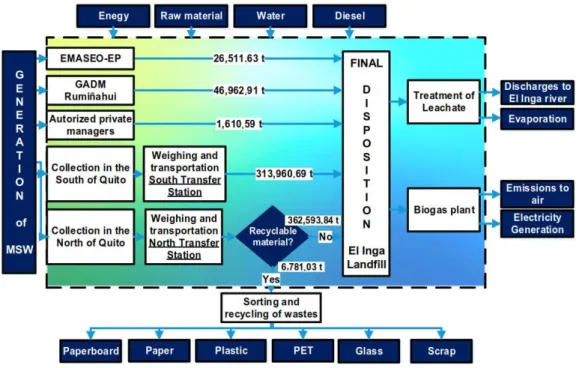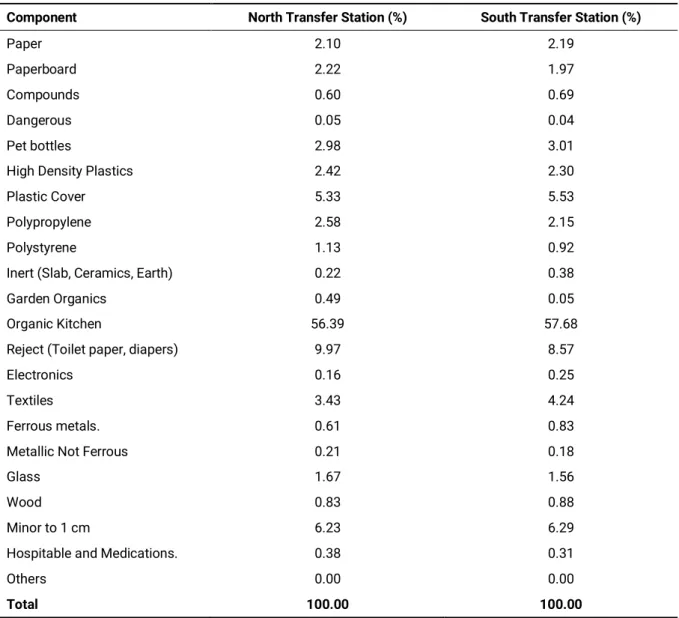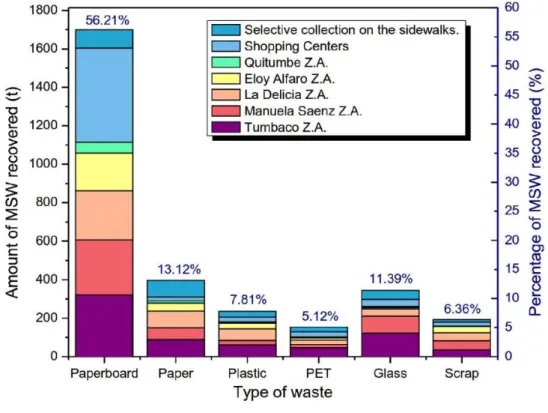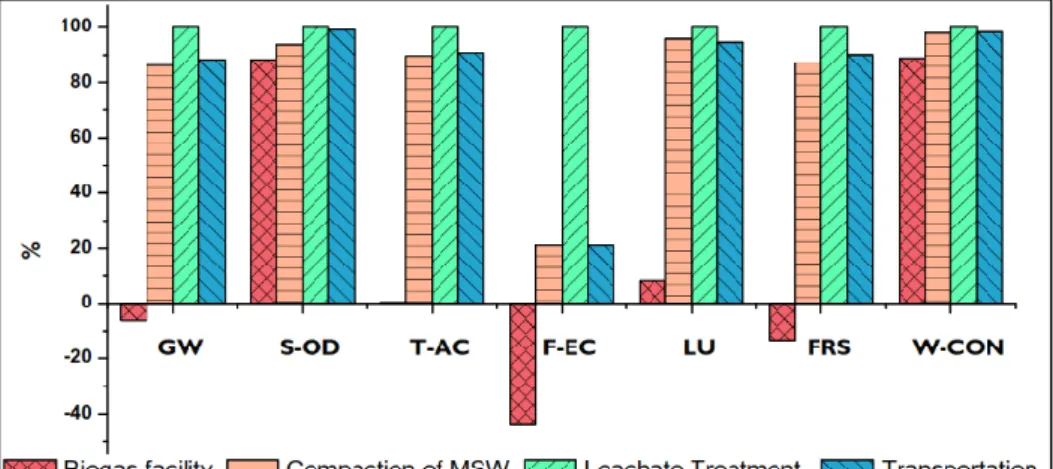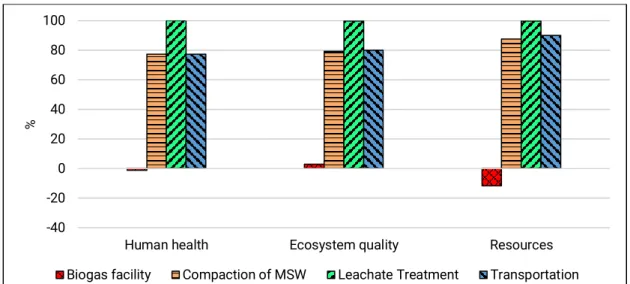Received: 10 April 2020 Accepted: 01 July 2020 Published: 24 July 2020 Copyright: © 2020 Chicaiza
Ortiz et al. This is an open access article distributed under a Creative Commons
Attribution License (CC BY), which allows for unrestricted use, distribution, and reproduction, as long as the original source is credited.
Funding: Secretaría de
Educación Superior, Ciencia, Tecnología e Innovación (SENESCYT), Ecuador.
Publisher:
..RESEARCH ARTICLE..
Evaluation of municipal solid waste
management system of Quito - Ecuador
through life cycle assessment approach
Avaliação do sistema de gestão de resíduos sólidos urbanos
de Quito - Equador através de análise de ciclo de vida
Evaluación del sistema de gestión de residuos sólidos urbanos
de Quito - Ecuador mediante análisis de ciclo de vida
Cristhian David Chicaiza Ortiz1,2*
Vanessa Pamela Navarrete Villa2
Christian Orlando Camacho López3
Ángel Fabián Chicaiza Ortiz3,4
1 Universidad Estatal Amazónica, UEA, Ecuador. Sede Académica El Pangui – Zamora
Chinchipe, Ecuador
2 Environmental Science and Engineering, Tianjin University, Tianjin, China
3 Grupo de Investigación de Recursos Mineros e Ingeniería, Escuela Superior Politécnica de
Chimborazo, Riobamba, Ecuador
4 Grupo Interdisciplinario de Estudios en Arquitectura y Construcción Sostenible. Universidad
Regional Amazónica Ikiam, Tena, Ecuador
* cristhianchicaiza@hotmail.com
Abstract
In Latin America and the Caribbean, the suitable processing of waste through the use of landfills is around 55%, while the local governments with municipal solid waste (MSW) management plans are around 20%. In Quito, for instance, approximately 2000 ton/day of solid waste are collected, and disposed in El Inga Landfill. The objective of this study is evaluating the MSW management of Quito through Life Cycle Assessment (LCA) approach. For achieving this goal, the ISO 14040 methodology was followed and SimaPro 8.4 was used as analysis software. The functional unit used is 1 ton of MSW, while, the material of study was the waste generated in households, commercial sector, schools and markets; whose values were obtained by the public companies EMASEO-EP, EMGIRS-EP, as well as from the open-access data of the city. The results show that using of biogas from the landfill allows the maximum saving of greenhouse gases (GHG) emissions. Therefore, the biogas plant is the process with less environmental impact. The compaction and transportation of MSW displayed a slightly higher impact comparing with the previous process, presenting the second-best environmental performance. On the other hand, the leachate treatment shows the greatest environmental impact according to the model, despite of the effluents does not exceed the permissible limits of the environmental Ecuadorian legislation. The researchers consider suitable the analysis of composting and anaerobic digestion techniques as complementary options to reduce this environmental impact, due to the high organic fraction in the analyzed waste.
Keywords: Life Cycle Assessment (LCA). Municipal Solid Waste Management.
Resumo
Na América Latina e no Caribe, o processamento adequado de resíduos através do uso de aterros sanitários é de cerca de 55%, enquanto os municípios com planos de gestão de resíduos sólidos urbanos (RSU) são cerca do 20%. Em Quito, por exemplo, aproximadamente 2000 ton/dia de resíduos sólidos são coletadas e depositadas no aterro de El Inga. O objetivo deste estudo é avaliar a gestão de RSU de Quito através da abordagem da avaliação do ciclo de vida (ACV). Para atingir esse objetivo, seguiu-se a metodologia ISO 14040 e o SimaPro 8.4 o software utilizado na análise. A unidade funcional utilizada é de 1 tonelada de RSU, enquanto o material de estudo foi o lixo gerado em residências, no setor comercial, escolas e mercados; cujos valores foram obtidos das empresas públicas EMASEO-EP, EMGIRS-EP e dos dados de acesso aberto da cidade. Os resultados mostram que o uso de biogás proveniente do aterro sanitário permite uma redução nas emissões de gases de efeito estufa (GEE), tornando a unidade de biogás como o processo com o menor impacto ambiental. A compactação e transporte de RSU apresentou um impacto ligeiramente superior em relação ao processo anterior, apresentando o segundo melhor desempenho ambiental. Por outro lado, o tratamento de lixiviados mostra o maior impacto ambiental de acordo com o modelo, apesar de que os efluentes não excederem os limites permitidos pela legislação ambiental equatoriana. Os investigadores consideram a análise das técnicas de compostagem e digestão anaeróbias adequadas, como opções complementares para reduzir esse impacto ambiental, devido à predominância da fração orgânica nos resíduos analisados.
Palavras-chave: Avaliação do Ciclo de Vida (ACV). Gestão Municipal de Resíduos
Sólidos. Aterro Sanitário. Equador.
Resumen
En América Latina y el Caribe, el procesamiento adecuado de los residuos mediante el uso de rellenos sanitarios es de alrededor del 55%, mientras que, los municipios con planes de gestión de residuos sólidos municipales (RSU) representan alrededor del 20%. En Quito, por ejemplo, se recolectan aproximadamente 2000 ton/día de residuos sólidos urbanos y se disponen en el vertedero El Inga. El objetivo de este estudio es evaluar la gestión de RSU de Quito a través del enfoque de análisis del ciclo de vida (ACV). Se siguió la metodología ISO 14040 y se utilizó SimaPro 8.4 como software de análisis. La unidad funcional utilizada es 1 tonelada de RSU, mientras que el material de estudio fueron los residuos generados en los hogares, el sector comercial, las escuelas y los mercados. Dichos valores fueron obtenidos de las empresas públicas EMASEO-EP, EMGIRS-EP, así como los datos de acceso abierto de la ciudad. Los resultados muestran que el uso de biogás del vertedero permite el máximo ahorro de emisiones de gases de efecto invernadero (GEI), por lo que la planta de biogás es el proceso con menor impacto ambiental. La compactación y el transporte de RSU mostraron un impacto con un ligero aumento con respecto al el proceso anterior, presentando el segundo mejor desempeño ambiental. Por otro lado, el tratamiento de lixiviados muestra el mayor impacto ambiental según el modelo, a pesar de que los efluentes no exceden los límites permisibles de la legislación ambiental ecuatoriana. Los investigadores consideran adecuado el análisis de las técnicas de compostaje y digestión anaeróbica como opciones complementarias para reducir este impacto ambiental, debido al predominio de la fracción orgánica en los residuos analizados.
Palabras clave: Análisis de Ciclos de Vida (ACV). Gestión de Residuos Sólidos
Urbanos. Relleno sanitario. Quito.
1. INTRODUCTION
Waste represent a significant challenge for human health and environment, especially in Latin America and the Caribbean (LA&C), where the implementation of modern technologies of MSW management and applicative approaches like the Circular Economy are delayed or nulled (Center for Clean Air Policy 2018; Goicochea, Fabregat 2015). Open dumps are still high in the region, thus most countries are trying to eradicate them, and adopting landfills. Nowadays, the options
for disposing MSW are sanitary landfills 36%, controlled landfills 25%, and uncontrolled dump sites 33% (Banco Interamericano de Desarrollo 2015; Margallo et al. 2019).
In Ecuador, around 11341 tons of waste are generated daily, that is, approximately 4139512 tons/year, of which 61.4% are organic, 9.4% paper or cardboard, 11% plastic, 2.6% glass and 2.2% scrap. Nevertheless, there is the possibility of recovering organic nutrients using biological waste treatment (Damgaard, Christensen 2010). The increase in the generation of MSW has slow down its management by need of high economic investment, representing a social, economic, and primarily environmental concern. Although, the Municipal Decentralized Autonomous Governments (GADs) have developed mechanisms to execute differentiated management, the advances within the territory are still insufficient. Thus, 80% of the 221 GADs dispose their waste in open dumps, ravines and on the riverbanks, and only 20% dispose their waste in manual, mechanized and shared sanitary landfills (Ministerio de Ambiente del Ecuador 2014).
The Metropolitan District of Quito, capital city of Ecuador has an area of 424717 ha (Carrion, Vasconez 2015) and a population of 2644145 inhabitants for 2017 according to the estimations of the National Institute of Statistics and Census (Instituto Nacional de Estadística y Censos 2019); and its production of waste collected per capita is 0.681 kg/day/person. This waste is treated and disposed in a technical and controlled manner into the Landfill of the Metropolitan District of Quito. The urban solid waste treatment starts with the excavation of a technically configured space for the final disposal, covered with a geomembrane for protect the natural soil from leachate liquids and a system for capturing biogas. Thus, El Inga landfill considers in its design the groundwater management, geological and geotechnical characteristics of the soil, ease of operation, leachate management and biogas extraction (EMGIRS-EP 2012).
The life Cycle Assessment (LCA) is used as a technique to assess the environmental impacts associated with all the stages of a product’s life from cradle-to-grave (Muralikrishna, Manickam 2017). Also, this technique allows to identify whose decisions should be taken to decrease the environmental loads, choosing the most desirable alternative based on a long-term evaluation (Pariatamby, Tanaka 2014).
The Life Cycle Assessment has been recently implemented in Ecuador, reason why, there are only few studies about this topic. Most of them have been focused on food products, for instance, Avadí et al. (2015) evaluated the Ecuadorian processed tuna; Pérez Neira (2016) assessed the cacao export and its contribution to climate change; Criollo & Salamea (2018) evaluated the Quinoa in the province of Imbabura-Ecuador; and Jaramillo (2019) evaluated a meat product as a strategy for a sustainable agribusiness. Moreover, some services have been evaluated, for instance, Remache (2017) evaluated the environmental impact of the Public Transport System of Tulcan; and Ramirez et al. (2015) assessed electricity network in Ecuador. However, none of
these studies has evaluated the MSW management in Ecuador, whereby, the present study represents a novel propose of research in the country.
In order to evaluate this issue, the method used in the present study is ReCiPe2016. It applies a cause-effect model, associated with time horizon, perspective, damaged pathway, among other factors. There are two mainstream approaches, which are complementary: midpoint and endpoint. The midpoint factors are located at the point after which the environmental mechanism is identical for all environmental flows. While the endpoint factors correspond to areas of protection: human health, ecosystem quality, and resource scarcity. Therefore, Endpoints provide better information, but it has more uncertainty than middle points (Huijbregts et al. 2017). Two perspectives can be evaluated for residues: modeling of waste disposal of a product or comparison of various waste disposal alternatives. It might allow finding the most suitable waste disposal and generates co-products as energy with the smallest loads on the environment (Klöpffer, Grahl 2014). Under this context, the present study evaluates the MSW management system of Quito - Ecuador through life cycle assessment approach, focusing on the management of domestic and commercial waste, because they are generated massively and continuously, representing an important environmental load.
2. MATERIALS AND METHODS
The evaluation was realized using the Environmental management - life cycle assessment - principles and framework, requirements and guidelines (International Standards Organization 2006), and four stages of analysis, which included scope and objective, inventory analysis, impact assessment and interpretation of results. A complementary guide considered was the Guidelines for National Greenhouse Gas Inventories developed by the Intergovernmental Panel on Climate Change (2019).
This research uses the average values of a year of activities, considering the following components: the consumption of fuels, electrical energy, chemical reagents, energy production, liquid discharges, gas emissions as well as their chemical composition, solid waste percentage. The key data for the replicability of the model has been displayed in the section of functional unit and system boundary. However, it is not possible to share all the input and output data due to confidential rules of the responsible institutions for MSW management.
2.1. Functional unit and system boundary
Quito produces approximately 2000 ton/day of solid waste, nearly 60% of this is organic waste (Tragsatec 2016). The temporary limits are set according to information available during the lapse of one year, since January to December 2017, and the functional unit will be 1 ton. The weight of MSW collected in the North and South transfer stations, EMASEO-EP, authorized
private managers and GADM Rumiñahui was 754854.16 ton in 2017 (from households, trade, markets, schools, markets). However, in the present study it was considered 751639.66 ton without considering the waste from hospital and wildlife waste (Municipio de Quito, 2017). The analysis covers the MSW management area of the Metropolitan District of Quito, which extension is 4183 Km2 (GADP Pichincha, 2017) with a population of 2'644145 inhabitants according to the National Institute of Statistics and Census (INEC) in 2017. Thus, the production of waste collected per capita was 0.681 kg/day/person. Figure 1 shows the limits and boundaries established for the present study.
Figure 1. Limits System for Management of MSW Metropolitan District of Quito.
2.2. Life cycle inventory and main assumptions
The characterization of the MSW used in this study, is presented in Table 1 (EMGIRS-EP 2013). The characterization values of the Leachate Treatment Plant and Biogas Plant were provided by the technicians of the Landfill, being necessary processing of raw data in order to get average values, used in the analysis.
Conscious of the restrictions for getting all the information from primary sources, some limitations were set stablished as follow: the infrastructure and the demolition of the facilities, in the same way, the management of hazardous, construction waste and incineration of wildlife are excluded.
Table 1. MSW Composition in the two transfers station in Quito-Ecuador.
Component North Transfer Station (%) South Transfer Station (%)
Paper 2.10 2.19
Paperboard 2.22 1.97
Compounds 0.60 0.69
Dangerous 0.05 0.04
Pet bottles 2.98 3.01
High Density Plastics 2.42 2.30
Plastic Cover 5.33 5.53
Polypropylene 2.58 2.15
Polystyrene 1.13 0.92
Inert (Slab, Ceramics, Earth) 0.22 0.38
Garden Organics 0.49 0.05
Organic Kitchen 56.39 57.68
Reject (Toilet paper, diapers) 9.97 8.57
Electronics 0.16 0.25
Textiles 3.43 4.24
Ferrous metals. 0.61 0.83
Metallic Not Ferrous 0.21 0.18
Glass 1.67 1.56
Wood 0.83 0.88
Minor to 1 cm 6.23 6.29
Hospitable and Medications. 0.38 0.31
Others 0.00 0.00
Total 100.00 100.00
The impact caused by the trucks that connect the Transfer Stations and El Inga landfill were evaluated. However, the following vehicles were not considered mechanical sweepers, pressure washers, skid steer loaders, side load collectors, front loading and rear loading, washing containers, dump trucks, truck tractors, trucks for collection in rural parishes and roll of-on truck. Neither the maintenance of the vehicles was not considered in this study and for collection.
2.3. Life cycle impacts assessment method (LCIA)
There are several methods and databases used worldwide such as: US Life Cycle Inventory Database, European Life Cycle Database (Hollerud et al. 2017), EDIP2003 (Hauschild, Potting 2005), Impact 2002 (Curran 2012), RECIPE, LIME, European Reference Life Cycle Database (ELCD), Ecological Footprint, ISO 14040 (2006) used in the context of LA&C (Bovea et al. 2016), etc. In order to achieve proper analysis, several categories are used, which imply a specific area of environmental assessment. Some of the categories used are: Global-Warming (GW)
potential, associated with climate change; Ozone layer depletion; Photochemical smog; Human and Ecotoxicity, related to public health; Resources conservation potential (Beylot, Villeneuve 2013; Chang, Pires 2015; Lausselet et al. 2016).
On the other hand, some research (Dong 2016) considered these next impact categories: GW, Acidification (AC), Terrestrial eutrophication (TE), Photochemical ozone formation to human health (POFh), Human toxicity via air (HTa), Human toxicity via solid (HTs), Ecotoxicity via solid (ETs). Though, some studies even considered all the available midpoints (Lam et al. 2018), this option is not a real solution for this approach. Therefore, the authors considered the most representatives midpoints in the field of the MSW and LCA for comparison proposes, they were: global warming, stratospheric ozone depletion, freshwater ecotoxicity, land use, fossil resource scarcity, water consumption. Whereas the endpoints considered were Human health, Ecosystems and Resources.
The impact evaluation was carried out with the software SimaPro 8.4, using the ReCiPe 2016 method, because it is demonstrated its reliability in several studies of LCA applied on MSW Management (Beylot, Villeneuve 2013; Lam et al. 2018; Lausselet et al. 2016). Besides, the recovered fraction used is show in the Figure 2, which was elaborated according to available data on the statistics.
Figure 2. Amount in tons and percentage recovered in 2017.
3. RESULTS AND DISCUSSION
The MSW management in Quito was analyzed in four stages: biogas generation, compaction, leachate treatment, and transportation. Figure 3 shows the main findings of the LCA study, which depicts the middle points with their endpoints. The abbreviations of the middle points are the next ones: GW: Global warming; S-OD: Stratospheric Ozone Depletion; T-AC: Terrestrial acidification; F-EC: Freshwater eutrophication; LU: Land use; FRS: Fossil resource scarcity; W-CON: Water consumption.
Figure 3. Environmental assessment through ReCiPe2016 (middle point) of four stages related to the MSW
Management in Quito-Ecuador.
3.1. Transportation
The waste is collected and stored mainly in the North or South Transfer Stations, where they hold processes of sorting. Moreover, entities like EMASEO–EP, GADM Rumiñahui, and authorized private managers are in charge of transporting MSW to its final destination “El Inga” Landfill. The distance between the Transfer Stations and the final disposition is 40 km approx., resulting in around 8 trips per day with an average of 27 ton transported per trip (EMGIRS-EP 2017).
Reason why, one of the seven parameters, Stratospheric Ozone depletion, displayed the maximum level of environmental load, mainly because of the gas emissions from the cars. Comparably, Jimenez (2013) obtained a high environmental impact in the transportation sector for the Municipality of Ecatepec-Mexico as well, with a population similar to Quito.
3.2. Compaction
The compaction is developed using 20 heavy machineries, among them: excavators, loaders, motor graders, rollers, compactors, among others. During, the 2017 the compaction carried out around 33618 trips approx., to decrease the waste volume. This process exhibits the second-best environmental performance, yet the difference with the previous stage is negligible. According
to the endpoints displayed in Figure 4, the use of resources had more influence than the ecosystem and Human health.
Figure 4. Environmental assessment through ReCiPe2016 (endpoint) of four stages related to the MSW
Management in Quito-Ecuador.
3.3. Leachate treatment
The compaction process creates an anaerobic environment for methane production. The areas where the waste is disposed (equals to 2100 ton/day) are covered with a geomembrane for fluids, where there is a system of pipes conducting the leachate to the leachates treatment plant (EMGIRS-EP, 2017). The data utilized for this stage involved two subprocesses: Leachate treatment plant (PTL) and Vibratory Shear Enhanced Processing (VSEP) treatments, while supplementary materials such as flocculants, coagulants, and acid compounds, were not considered. The system of VSEP can treat 250 m3/day on average. After treatment, the clean wastewater is discharged to El Inga river (EMGIRS-EP, 2017).
Its environmental performance, according to the results, shows having the greatest load, although it could be due to the limitations mentioned in Section 2.2 Life cycle inventory and main assumptions. Furthermore, the values of discharges do not exceed the permissible limits of the Ecuadorian legislation, fact allows guaranteeing the correct disposition of treated leachates to El Inga river.
3.4. Biogas Recovery Facility
The biogas capture system was implemented in two phases: the first one, in February 2016 (2MW) and other in March 2017 (3MW), contributing with a total of 5MW. With the plant located within El Inga Landfill, 26000000 m3 of biogas into the environment stopped emitting, which means 250000 tons of Carbon Dioxide (Secretaría de Ambiente 2017).
-40 -20 0 20 40 60 80 100
Human health Ecosystem quality Resources
%
Thus, the Municipality takes advantage of it, receiving a change of 500000 carbon certificates for reducing pollutants.
Figure 3 displays the environmental efficiency of the biogas recovery facility thought negative values at 3 midpoints: global warming, the ecotoxicity of fresh water and the scarcity of fossil resources, since the process prevents emissions of GHG, and it allows the availability of electricity near the area.
4. CONCLUSION
Quito generated approximately 200 tons daily during 2017, however, some implementations were done forward to reach the goals of the municipality in MSW management. For instance, in 2017 mid-year the GAD started up a separation plant in the North Transfer Station, as well as, the full operability of 5 MW, reached since March 2017.
A life cycle assessment was conducted using the ReCiPe 2016 method, finding that the biogas capture system is the process with less environmental impact, showing even some negative values. The second process with less impact is the compaction, with loads in almost all the parameters very close to transportation, the third one. The process with the greatest impact according to the proposed model is the leachate plant, nonetheless, the effluents of its process did not exceed the limits based in the Ecuadorian legislation in any parameter.
For future studies, it is suggested to consider social and economic factors to have an integral assessment of this service, as well as, evaluating some scenarios considering the high percentage of organic matter. In the same way, recycling process could be an interesting case of study in the future, not just for the environmental load saving, but also for the generation of incomes to the people that work near to the area.
ACKNOWLEDGEMENTS
The authors thank the staff of EMASEO-EP, EMGIRS-EP for the access to the information. Finally, thank to the SENESCYT (Secretaría de Educación Superior, Ciencia, Tecnología e Innovación) of Ecuador, for its scholarship programs.
REFERENCES
ALCALDÍA METROPOLITANA DE QUITO, 2015. Plan Metropolitano de Desarrollo y Ordenamiento Territorial.
Secretaría General de Planificación, Secretaría de Territorio, Hábitat y Vivienda. Quito, Ecuador [online]. 2015.
[Accessed 8 September 2019]. Available from: http://www.quito.gob.ec/documents/PMDOT.pdf
AVADÍ, Angel, BOLAÑOS, Carolina, SANDOVAL, Isabel and YCAZA, Carla, 2015. Life cycle assessment of Ecuadorian processed tuna. The International Journal of Life Cycle Assessment [online]. 1 October 2015. Vol. 20, no. 10, p. 1415–1428. [Accessed 13 May 2020]. DOI 10.1007/s11367-015-0943-2. Available from:
BANCO INTERAMERICANO DE DESARROLLO, 2015. Situación de la gestión de residuos sólidos en América Latina y el Caribe. [online]. 2015. [Accessed 12 September 2019]. Available from:
https://publications.iadb.org/bitstream/handle/11319/7177/Situacion_de_la_gestion_de_residuos_solidos_en_A merica_Latina_y_el_Caribe.pdf?sequence=1
BEYLOT, Antoine and VILLENEUVE, Jacques, 2013. Environmental impacts of residual Municipal Solid Waste incineration: A comparison of 110 French incinerators using a life cycle approach. Waste Management [online]. December 2013. Vol. 33, no. 12, p. 2781–2788. [Accessed 8 May 2019]. DOI 10.1016/j.wasman.2013.07.003. Available from: https://linkinghub.elsevier.com/retrieve/pii/S0956053X1300305X
BOVEA, María D., CRUZ-SOTELO, Samantha E., MERCANTE, Irma, COUTINHO-NÓBREGA, Claudia, ELJAIEK-URSOLA, Mónica and IBÁÑEZ-FLORES, Valeria, 2016. Aplicación de la metodología de análisis de ciclo de vida para evaluar el desempeño ambiental de sistemas de gestión de residuos en Iberoamérica. Revista Internacional
de Contaminación Ambiental [online]. 30 December 2016. Vol. 32, no. Residuos sólidos, p. 23–46. [Accessed 25
August 2019]. DOI 10.20937/RICA.2016.32.05.03. Available from:
http://www.revistascca.unam.mx/rica/index.php/rica/article/view/RICA.2016.32.05.03/46671
CARRION, Diego and VASCONEZ, Jaime, 2015. The case of Quito, Ecuador. [online]. 2015. [Accessed 6 September 2019]. Available from: https://www.ucl.ac.uk/dpu-projects/Global_Report/pdfs/Quito.pdf
CENTER FOR CLEAN AIR POLICY, 2018. High-level Pre-feasibility Study and Implementation Plan for an Organic Waste Treatment Project in the Municipality of Quito. CCAC MSW Initiative [online]. 2018. [Accessed 15 December 2019]. Available from:
http://www.waste.ccacoalition.org/document/high-level-pre-feasibility-study-and-implementation-plan-organic-waste-treatment-project
CHANG, Ni-Bin and PIRES, Ana, 2015. Fuzzy Multiobjective Decision-Making for Solid Waste Management. In: CHANG, Ni‐Bin and PIRES, Ana, Sustainable Solid Waste Management [online]. Hoboken, NJ, USA: John Wiley & Sons, Inc. p. 791–827. [Accessed 20 July 2020]. ISBN 978-1-119-03584-8. Available from:
http://doi.wiley.com/10.1002/9781119035848.ch22
CRIOLLO OÑA, Klever Alberto and SALAMEA ROMERO, Carolina Elizabeth, 2018. Análisis de Ciclo de Vida de la
Quinua (Chenopodium Quinoa) producida en la provincia de Imbabura [online]. Trabajo de titulación (Ingeniería
ambiental). Quito, Ecuador: Universidad Politécnica Salesiana. [Accessed 13 May 2020]. Available from:
https://dspace.ups.edu.ec/handle/123456789/15242
CURRAN, Mary Ann, 2012. Life Cycle Assessment Handbook: A Guide for Environmentally Sustainable Products [online]. Cincinnati, USA: Scrivener; Wiley & Sons. [Accessed 8 October 2019]. Available from:
https://books.google.com/books?id=EYp1Ld2ozbkC
DAMGAARD, Anders and CHRISTENSEN, Thomas, 2010. Implementation of life cycle assessment models in solid waste management. Denmark: Technical University of Denmark [online]. 2010. [Accessed 5 October 2019]. Available from: https://www.semanticscholar.org/paper/Implementation-of-life-cycle-assessment-models-in-Damgaard-Christensen/910c503f598bdb9909451d39a690f6a861d0afee
DONG, Jun, 2016. MSWs gasification with emphasis on energy, environment and life cycle assessment [online]. phdthesis. Ecole des Mines d’Albi-Carmaux ; Zhejiang University. Institute for Thermal Power Engineering. [Accessed 5 October 2019]. Available from: https://tel.archives-ouvertes.fr/tel-01540764
EMGIRS-EP, 2012. Relleno sanitario del distrito metropolitano de Quito. [online]. 2012. [Accessed 17 May 2020]. Available from: https://www.emgirs.gob.ec/index.php/zentools/zentools-slideshow
EMGIRS-EP, 2013. Characterization of solid urban waste. [online]. 2013. [Accessed 15 October 2019]. Available from:
https://tel.archives-ouvertes.fr/tel-01540764/document https://www.emgirs.gob.ec/index.php/zenkit/visitas-al-relleno-sanitario-2
EMGIRS-EP, 2017. Statistics of the operation of the Quito sanitary, transfer stations. [online]. 2017. [Accessed 15 October 2019]. Available from: https://www.emgirs.gob.ec/index.php/zentools/zentools-list
GADP PICHINCHA, 2017. Distrito Metropolitano de Quito. [online]. 2017. [Accessed 15 October 2019]. Available from: http://www.pichincha.gob.ec/cantones/distrito-metropolitano-de-quito
GOICOCHEA, Odalys and FABREGAT, Jorge, 2015. Enfoque del ciclo de vida para la evaluación ambiental de las estrategias de manejo de los residuos sólidos domésticos en La Habana, Cuba. Ciencias de la Tierra y el Espacio [online]. 2015. Vol. 16, no. 1, p. 2–16. [Accessed 5 August 2019]. Available from: http://docplayer.es/77080521- Enfoque-del-ciclo-de-vida-para-la-evaluacion-ambiental-de-las-estrategias-de-manejo-de-los-residuos-solidos-domesticos-en-la-habana-cuba.html
HAUSCHILD, Michael and POTTING, José, 2005. Spatial Differentiation in Life Cycle Impact Assessment.
Environmental News, Technical University of Denmark [online]. 2005. No. 80. [Accessed 15 November 2019].
Available from: https://www2.mst.dk/udgiv/publications/2005/87-7614-579-4/pdf/87-7614-580-8.pdf
HOLLERUD, Bailey, BOWYER, Jim, HOWE, Jeff, PEPKE, Ed and FERNHOLZ, Kathryn, 2017. A review of Life Cycle
Assessment Tools [online]. Minneapolis, USA: Dovetail Partners. [Accessed 5 August 2019]. Available from: https://dovetailinc.org/upload/tmp/1579558516.pdf
HUIJBREGTS, Mark A. J., STEINMANN, Zoran J. N., ELSHOUT, Pieter M. F., STAM, Gea, VERONES, Francesca, VIEIRA, Marisa, ZIJP, Michiel, HOLLANDER, Anne and VAN ZELM, Rosalie, 2017. ReCiPe2016: a harmonised life cycle impact assessment method at midpoint and endpoint level. The International Journal of Life Cycle
Assessment [online]. 1 February 2017. Vol. 22, no. 2, p. 138–147. [Accessed 19 July 2020]. DOI
10.1007/s11367-016-1246-y. Available from: https://doi.org/10.1007/s11367-016-1246-y
INSTITUTO NACIONAL DE ESTADÍSTICA Y CENSOS, 2019. INEC [online]. 2019. [Accessed 20 December 2019]. Available from: https://www.ecuadorencifras.gob.ec/estadisticas/
INTERNATIONAL PANEL ON CLIMATE CHANGE, 2019. Refinement to the 2006 IPCC Guidelines for National
Greenhouse Gas Inventories [online]. Switzerland: IPCC. [Accessed 13 December 2019]. Available from: https://www.ipcc-nggip.iges.or.jp/public/2019rf/index.html
INTERNATIONAL STANDARDS ORGANIZATION, 2006. ISO 14040: 2006 Environmental management: Life cycle
assessment: Principles and framework [online]. Geneva, CH: ISO. [Accessed 13 January 2020]. Available from: https://www.iso.org/standard/37456.html
JARAMILLO PINEDA, Carlos Armando, 2019. Análisis de ciclo de vida (ACV) de un producto cárnico, como
estrategia para un Agronegocio sustentable: un estudio en la unidad Eduproductiva de la Universidad Técnica del Norte [online]. Trabajo de Grado (Ingeniería en Agronegocios Avalúos y Catastros). Imbabura, Ecuador:
Universidad Técnica del Norte. [Accessed 13 May 2020]. Available from:
http://repositorio.utn.edu.ec/handle/123456789/8811
JIMÉNEZ, U., 2013. Análisis de ciclo de vida de las botellas de PET que se recolectan como residuo en el Municipio
de Ecatepec de Morelosc [online]. Tesis de Doctorado. [Accessed 3 May 2020]. Available from:
http://www.ptolomeo.unam.mx:8080/xmlui/bitstream/handle/132.248.52.100/6157/tesis.pdf?sequence=1
KLÖPFFER, Walter and GRAHL, Birgit, 2014. Life Cycle Assessment (LCA): a guide to best practice. Weinheim, Germany: Wiley-VCHVerlag GmbH & Co. KGaA. ISBN 978-3-527-32986-1.
LAM, Chor-Man, YU, Iris K.M., HSU, Shu-Chien and TSANG, Daniel C.W., 2018. Life-cycle assessment on food waste valorisation to value-added products. Journal of Cleaner Production [online]. October 2018. Vol. 199, p. 840–848. [Accessed 19 July 2020]. DOI 10.1016/j.jclepro.2018.07.199. Available from:
https://linkinghub.elsevier.com/retrieve/pii/S0959652618321899
LAUSSELET, Carine, CHERUBINI, Francesco, DEL ALAMO SERRANO, Gonzalo, BECIDAN, Michael and STRØMMAN, Anders Hammer, 2016. Life-cycle assessment of a Waste-to-Energy plant in central Norway: Current situation and effects of changes in waste fraction composition. Waste Management [online]. December 2016. Vol. 58, p. 191– 201. [Accessed 19 July 2020]. DOI 10.1016/j.wasman.2016.09.014. Available from:
https://linkinghub.elsevier.com/retrieve/pii/S0956053X16305177
MARGALLO, María, ZIEGLER-RODRIGUEZ, Kurt, VÁZQUEZ-ROWE, Ian, ALDACO, Rubén, IRABIEN, Ángel and KAHHAT, Ramzy, 2019. Enhancing waste management strategies in Latin America under a holistic environmental assessment perspective: A review for policy support. Science of The Total Environment [online]. 1 November 2019. Vol. 689, p. 1255–1275. [Accessed 19 July 2020]. DOI 10.1016/j.scitotenv.2019.06.393. Available from:
MINISTERIO DE AMBIENTE DEL ECUADOR, 2014. Informe de gestión MAE-PNGIDS 2010-2013. [online]. 2014. [Accessed 15 October 2019]. Available from:
http://suia.ambiente.gob.ec/documents/10179/254996/Informe+Gestion+detallado+MAE-PGNIDS+2010-2013.pdf/0b66f1c8-98bc-430a-bdab-75f8e7afeed0
MUNICIPIO DE QUITO, 2017. Rendición de cuentas Quito. [online]. 2017. [Accessed 10 October 2019]. Available from: http://www.quito.gob.ec/documents/rendicion_cuentas2016/MQ_rendicion_cuentas_2016.pdf
MURALIKRISHNA, I. V. and MANICKAM, Valli, 2017. Environmental management: science and engineering for
industry. Oxford, United Kingdom ; Cambridge, MA: Butterworth-Heinemann, an imprint of Elsevier. ISBN
978-0-12-811989-1.
PARIATAMBY, Agamuthu and TANAKA, Masaru (eds.), 2014. Municipal solid waste management in asia and the
pacific islands: challenges and strategic solutions. Singapore: Springer. Environmental science and engineering.
ISBN 978-981-4451-73-4.
PÉREZ NEIRA, David, 2016. Energy sustainability of Ecuadorian cacao export and its contribution to climate change. A case study through product life cycle assessment. Journal of Cleaner Production [online]. 20 January 2016. Vol. 112, p. 2560–2568. [Accessed 19 July 2020]. DOI 10.1016/j.jclepro.2015.11.003. Available from:
http://www.sciencedirect.com/science/article/pii/S0959652615016108
RAMIREZ, Angel, RIVELA, Beatriz, BOERO, Andrea, MELENDRES, Ana and ESPINOZA, Vicente, 2015. Life cycle assessment of Ecuadorian electricity. In: VI Conferencia Internacional de Análisis de Ciclo de Vida en
Latinoamerica [online]. 13 July 2015. [Accessed 13 May 2020]. Available from:
https://www.researchgate.net/profile/Beatriz_Rivela/publication/281454976_Life_cycle_assessment_of_Ecuador ian_electricity/links/55f8999708aeafc8ac14803f.pdf
REMACHE VINUEZA, Byron, 2017. Estudio de factibilidad para la implementación de la metodología de Análisis de Ciclo de Vida (ACV) en la valoración del impacto ambiental del sistema de transporte público de Tulcán. In: II
Congreso Internacional de Ciencias Sociales y Económicas: Herramientas para Fortalecer la Competitividad Sistémica de la Provincia del Carchi [online]. Tulca, Ecuador. 7 April 2017. [Accessed 13 May 2020]. Available
from:
https://www.researchgate.net/publication/323588967_Estudio_de_factibilidad_para_la_implementacion_de_la_m etodologia_de_Analisis_de_Ciclo_de_Vida_ACV_en_la_valoracion_del_impacto_ambiental_del_sistema_de_transp orte_publico_de_Tulcan
SECRETARÍA DE AMBIENTE, 2017. Quito se destaca en el Ecuador al producir energía eléctrica de la basura.
Agencia Pública de Noticias de Quito [online]. 16 October 2017. [Accessed 8 September 2019]. Available from: http://prensa.quito.gob.ec/index.php?module=Noticias&func=news_user_view&id=28620&umt=Quito%20se%20d estaca%20en%20el%20Ecuador%20al%20producir%20energ%25EDa%20el%25E9ctrica%20de%20la%20basura
TRAGSATEC, 2016. Plan Maestro Gestión Integral. [online]. 2016. [Accessed 10 October 2019]. Available from:
http://www.quitoambiente.gob.ec/ambiente/index.php/politicas-y-planeacion-ambiental/residuos-solidos/plan-maestro-gestion-integral
WONG, Jonathan W. C., SURAMPALLI, Rao Y., ZHANG, Tian C., TYAGI, Rajeshwar D. and SELVAM, Ammaiyappan (eds.), 2016. Sustainable Solid Waste Management [online]. Reston, VA: American Society of Civil Engineers. [Accessed 18 July 2020]. ISBN 978-0-7844-1410-1. Available from:
